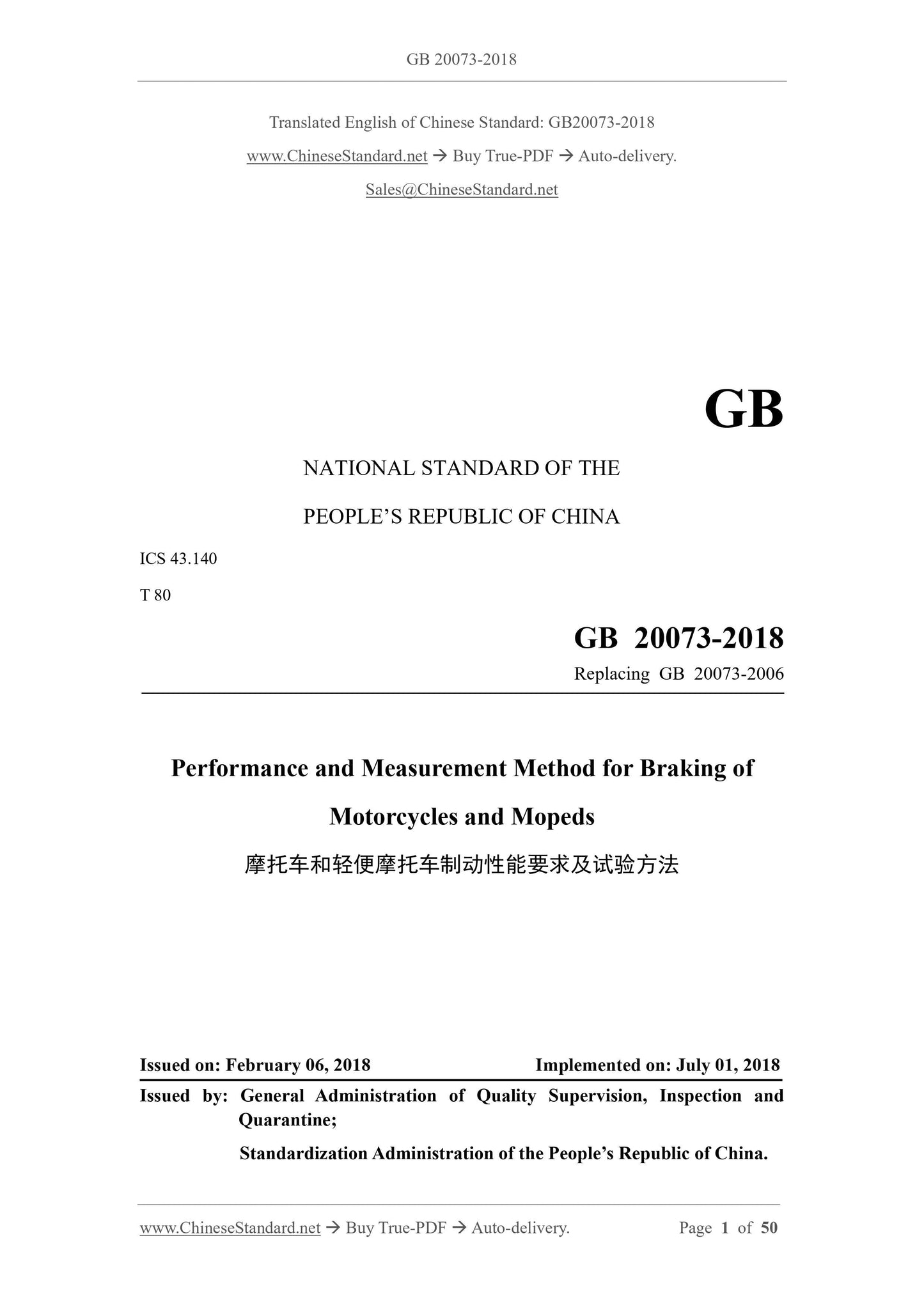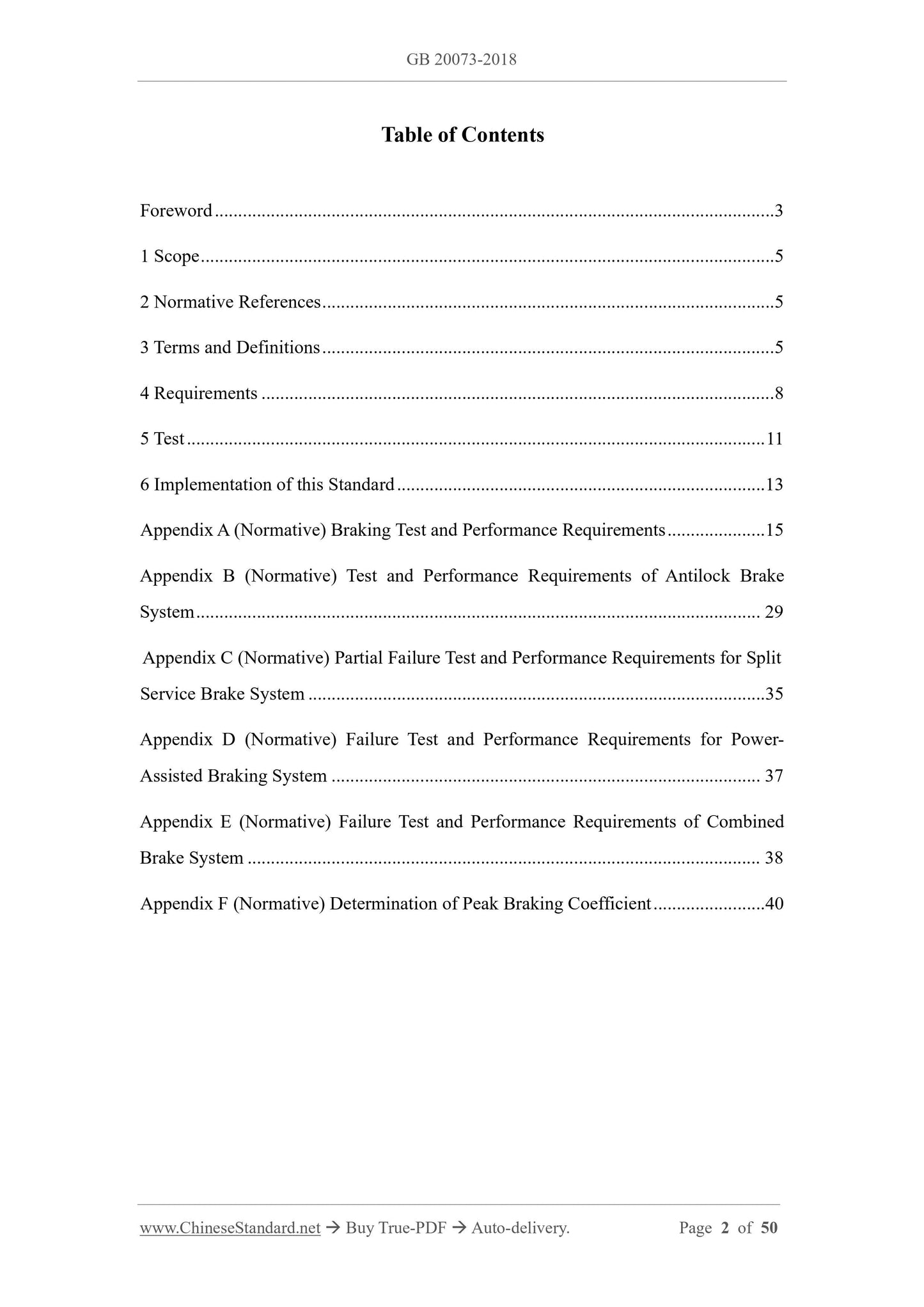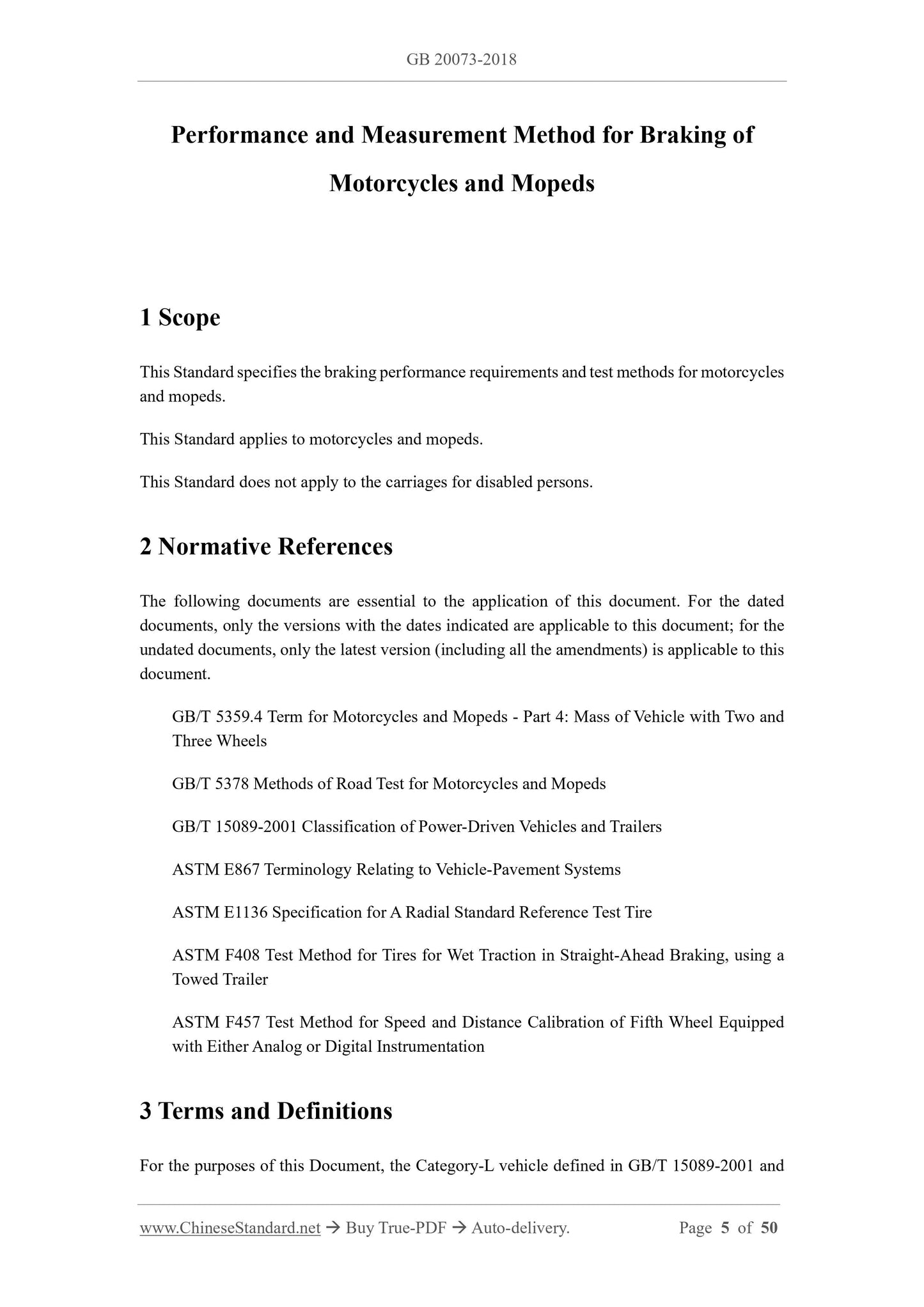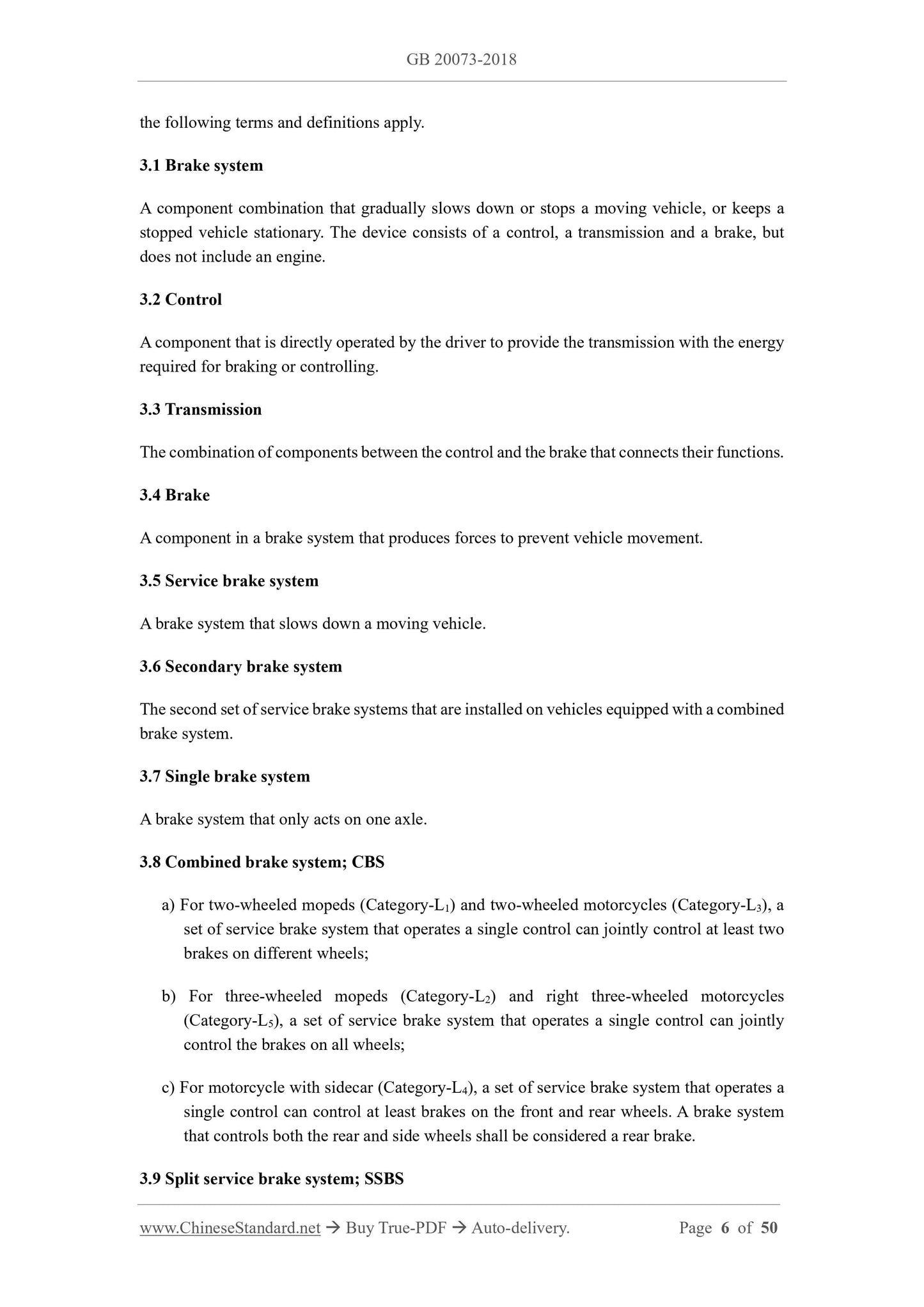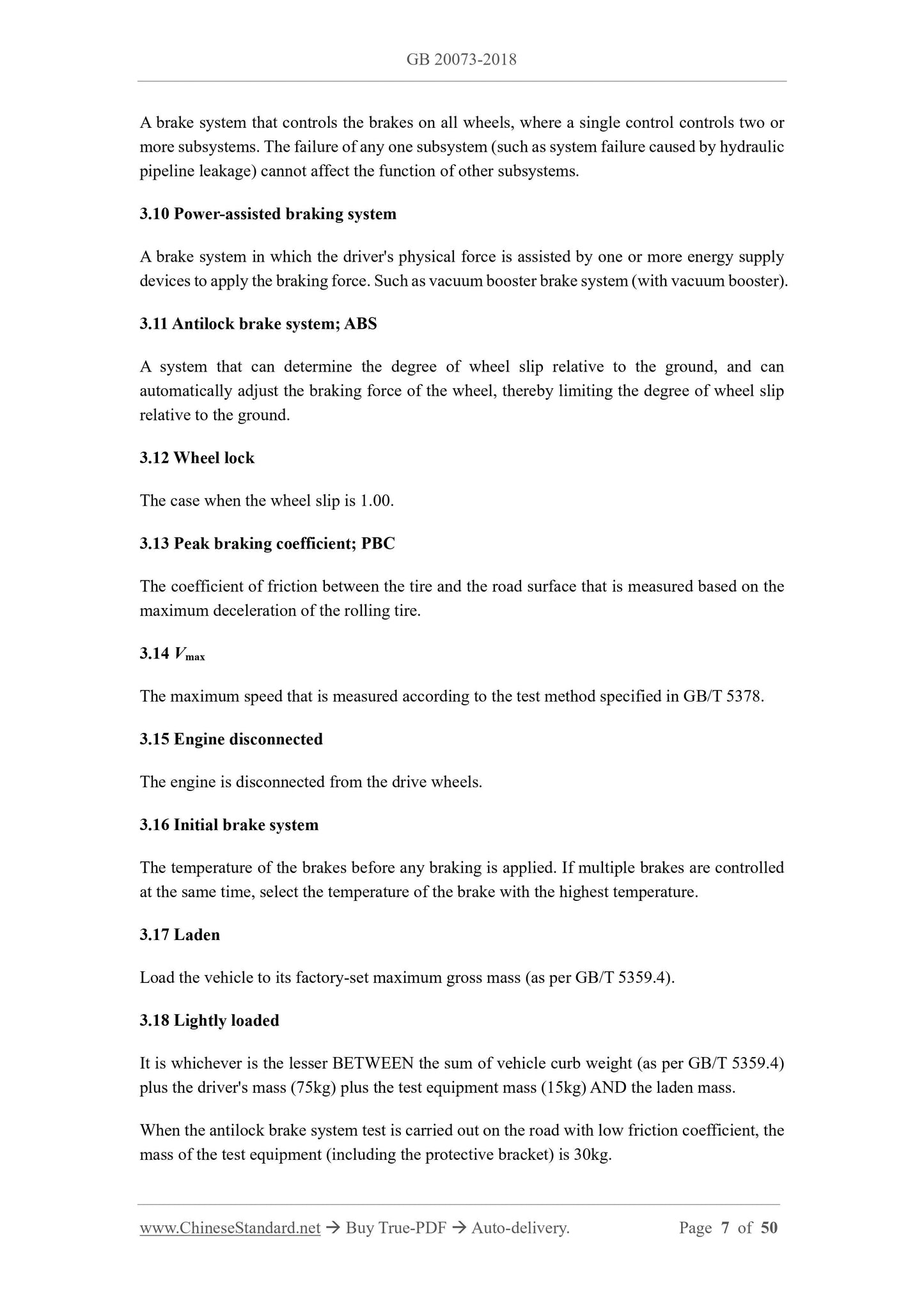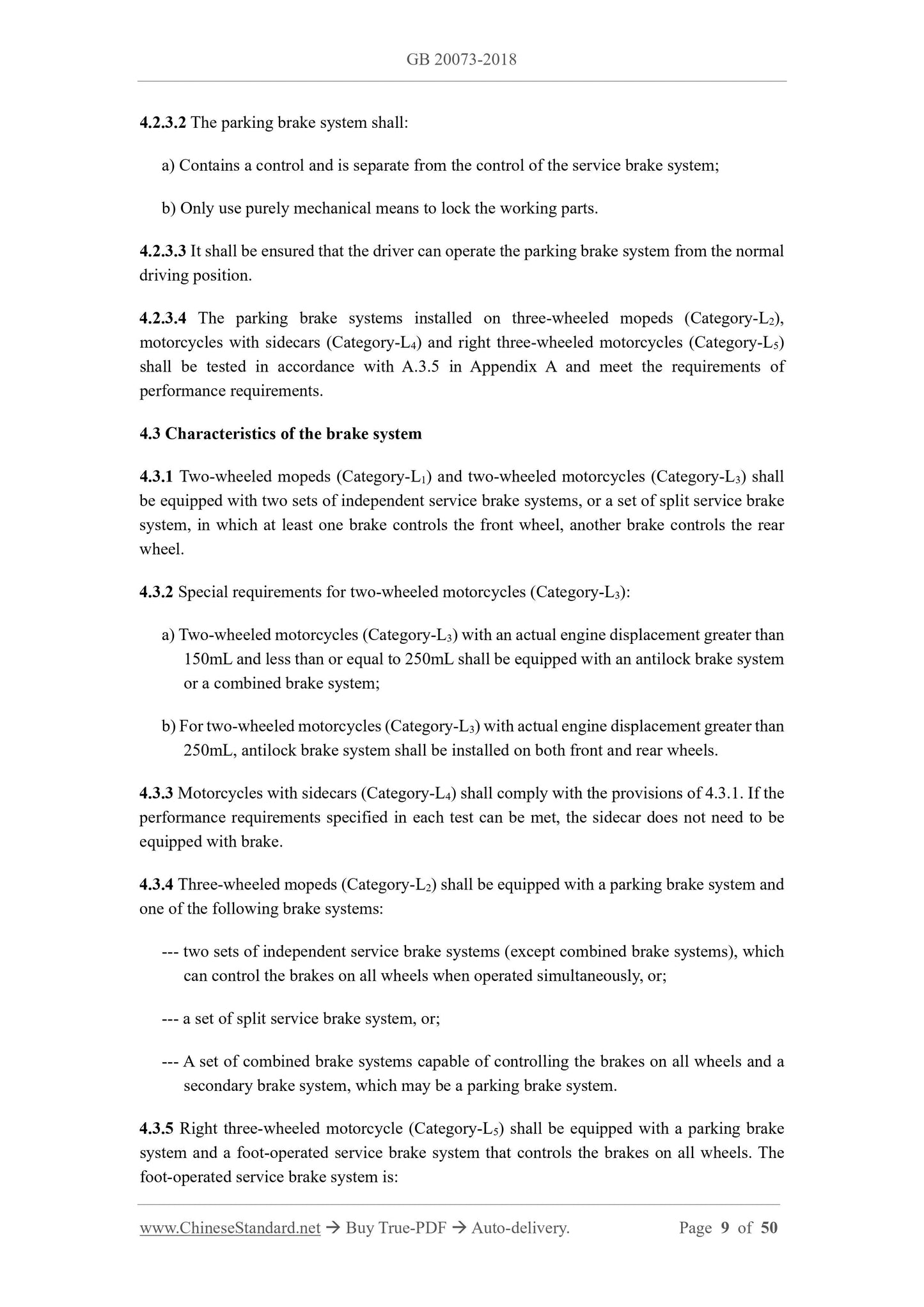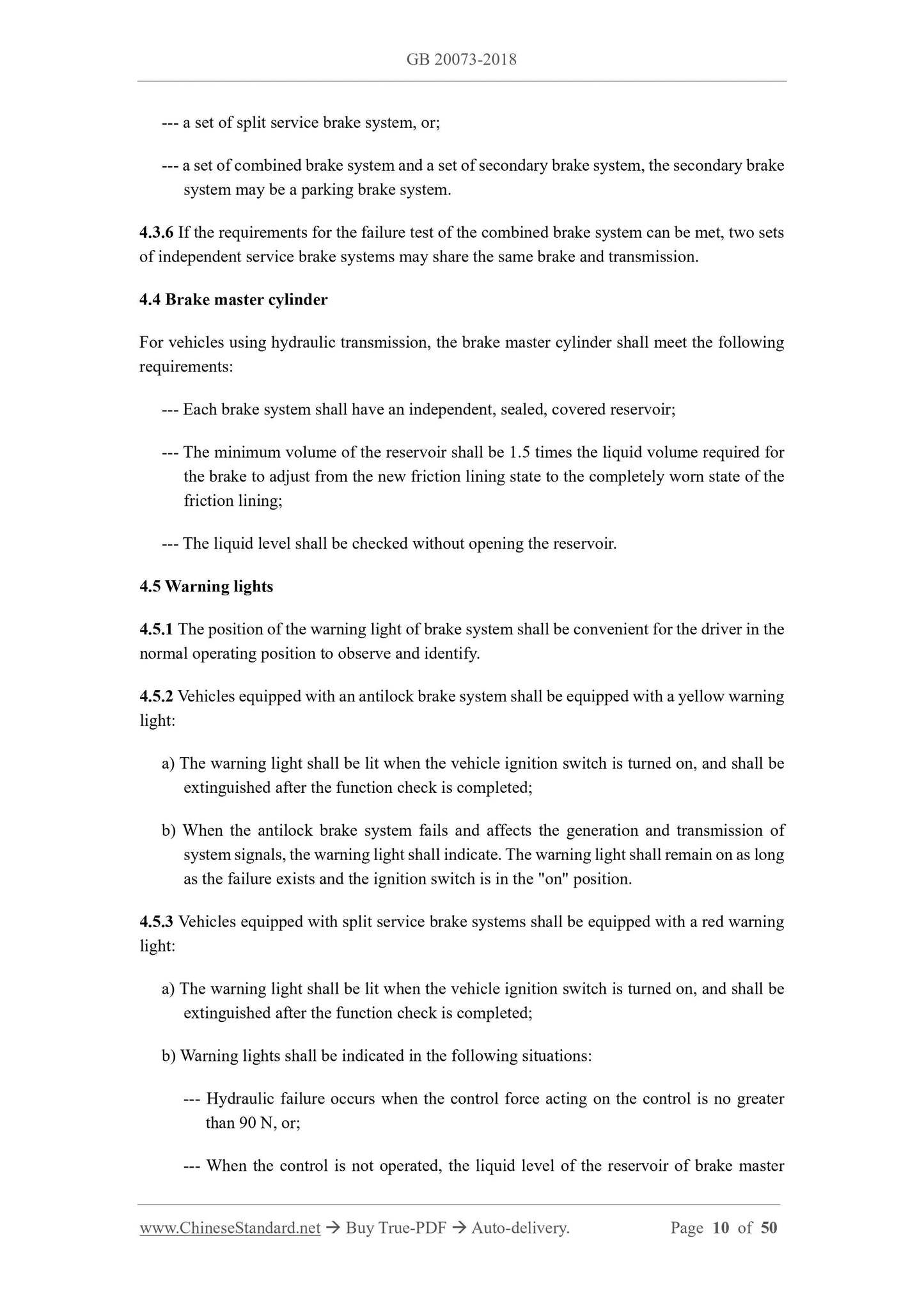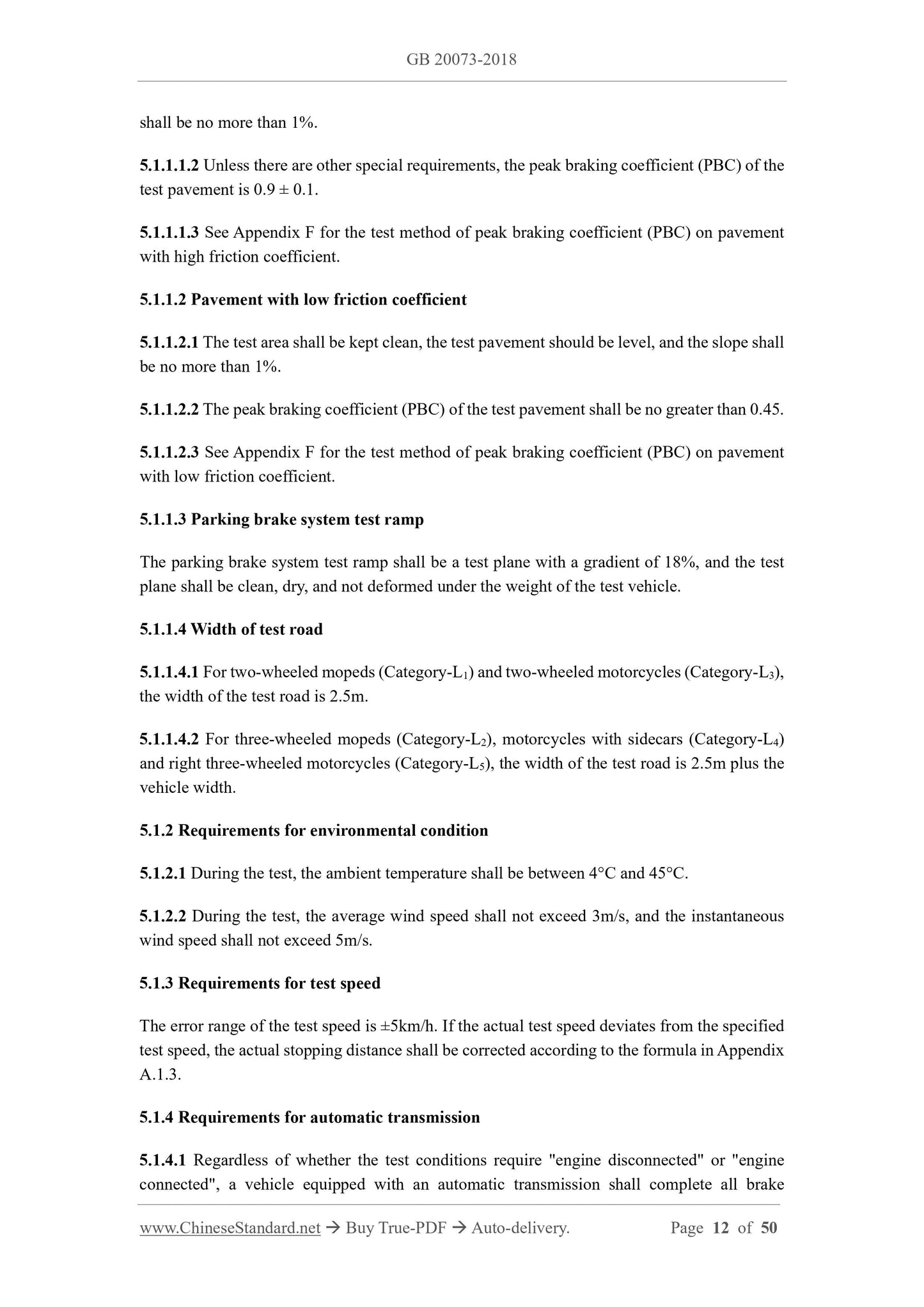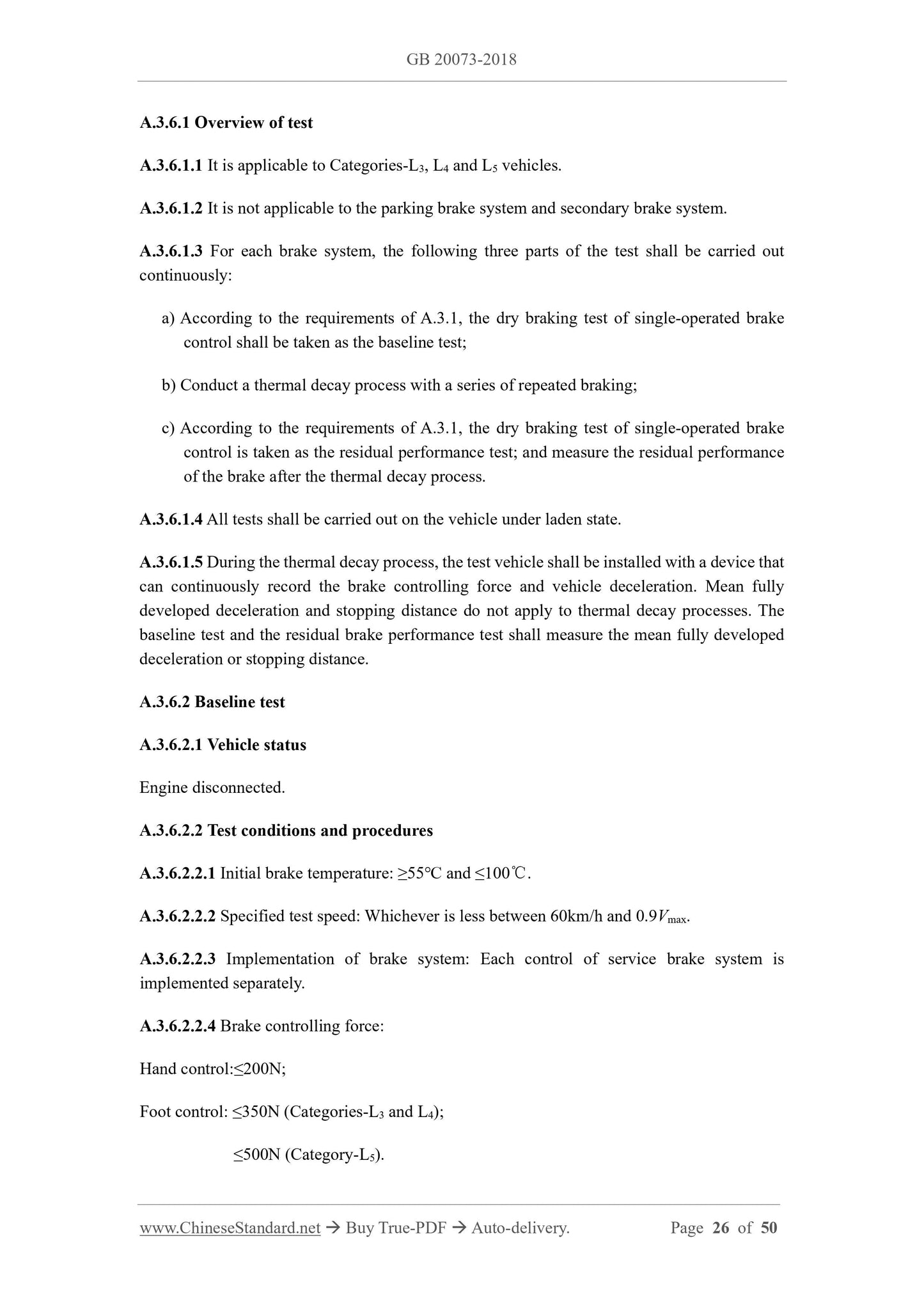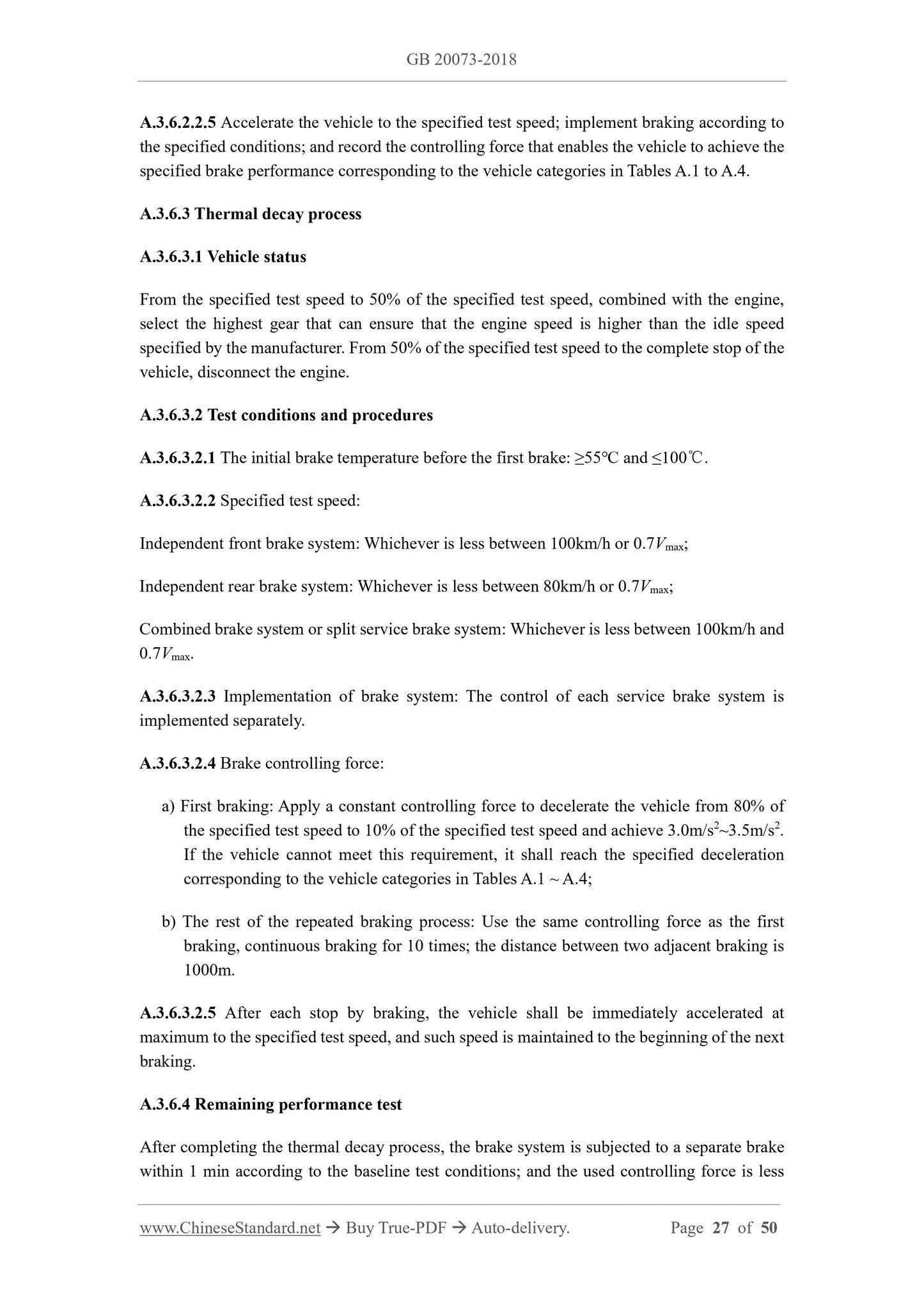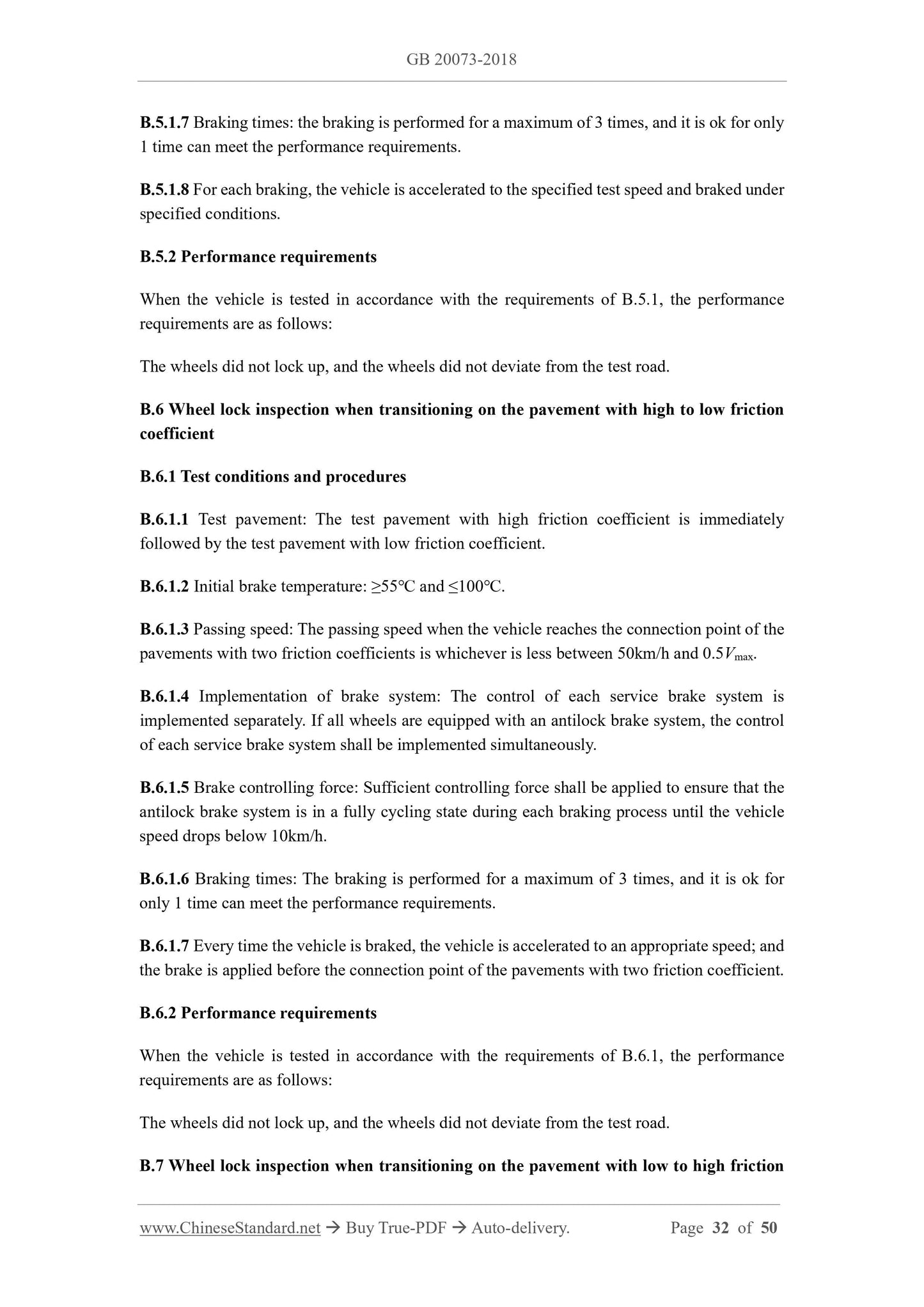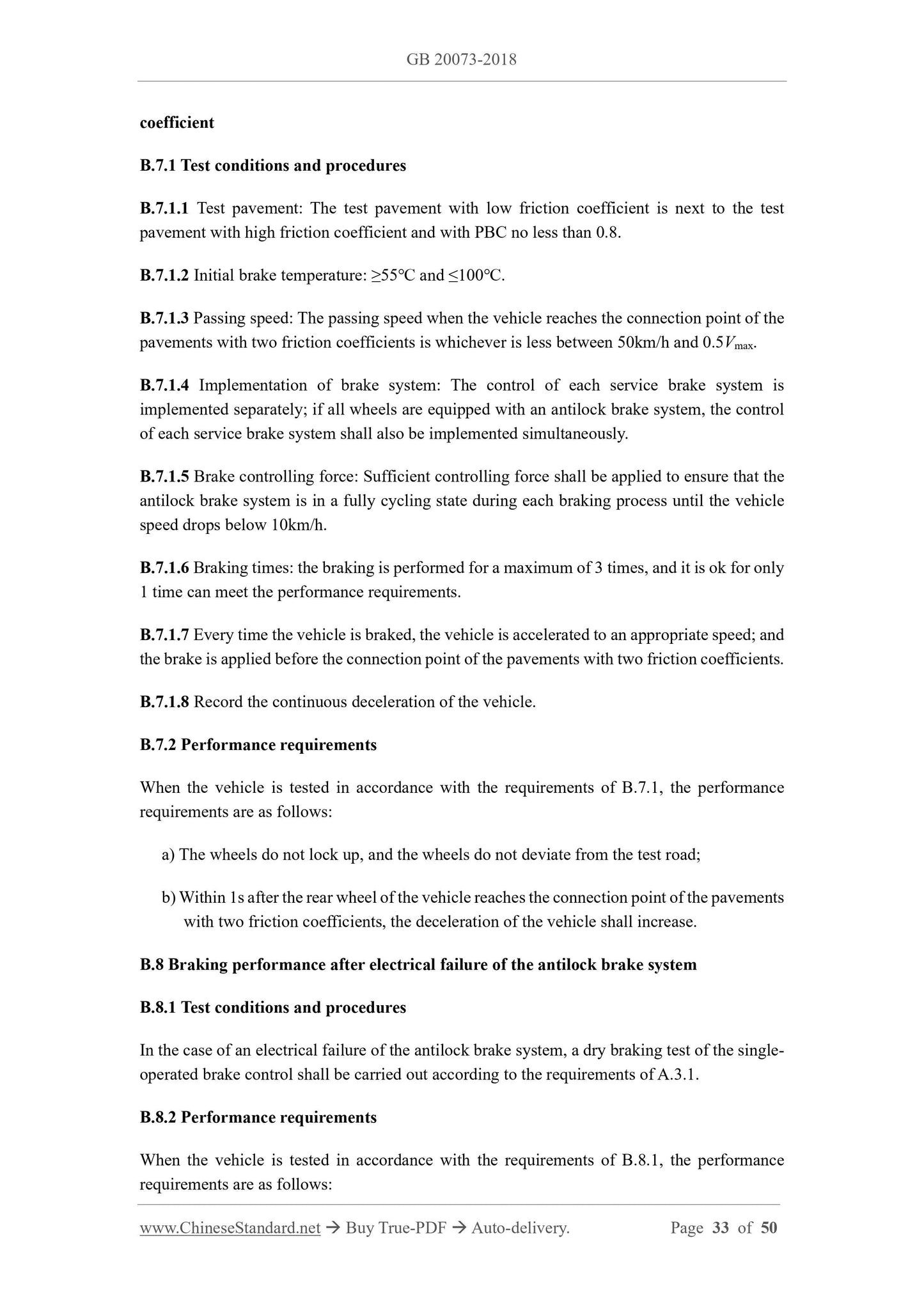1
/
of
12
www.ChineseStandard.us -- Field Test Asia Pte. Ltd.
GB 20073-2018 English PDF
GB 20073-2018 English PDF
Regular price
$415.00
Regular price
Sale price
$415.00
Unit price
/
per
Shipping calculated at checkout.
Couldn't load pickup availability
GB 20073-2018: Performance and measurement method for braking of motorcycles and mopeds
Delivery: 9 seconds. Download (& Email) true-PDF + Invoice.
Get Quotation: Click GB 20073-2018 (Self-service in 1-minute)
Historical versions (Master-website): GB 20073-2018
Preview True-PDF (Reload/Scroll-down if blank)
GB 20073-2018
NATIONAL STANDARD OF THE
PEOPLE’S REPUBLIC OF CHINA
ICS 43.140
T 80
Replacing GB 20073-2006
Performance and Measurement Method for Braking of
Motorcycles and Mopeds
ISSUED ON: FEBRUARY 06, 2018
IMPLEMENTED ON: JULY 01, 2018
Issued by: General Administration of Quality Supervision, Inspection and
Quarantine;
Standardization Administration of the People’s Republic of China.
Table of Contents
Foreword ... 3
1 Scope ... 5
2 Normative References ... 5
3 Terms and Definitions ... 5
4 Requirements ... 8
5 Test ... 11
6 Implementation of this Standard ... 13
Appendix A (Normative) Braking Test and Performance Requirements ... 15
Appendix B (Normative) Test and Performance Requirements of Antilock Brake
System ... 29
Appendix C (Normative) Partial Failure Test and Performance Requirements for Split
Service Brake System ... 35
Appendix D (Normative) Failure Test and Performance Requirements for Power-
Assisted Braking System ... 37
Appendix E (Normative) Failure Test and Performance Requirements of Combined
Brake System ... 38
Appendix F (Normative) Determination of Peak Braking Coefficient ... 40
Performance and Measurement Method for Braking of
Motorcycles and Mopeds
1 Scope
This Standard specifies the braking performance requirements and test methods for motorcycles
and mopeds.
This Standard applies to motorcycles and mopeds.
This Standard does not apply to the carriages for disabled persons.
2 Normative References
The following documents are essential to the application of this document. For the dated
documents, only the versions with the dates indicated are applicable to this document; for the
undated documents, only the latest version (including all the amendments) is applicable to this
document.
GB/T 5359.4 Term for Motorcycles and Mopeds - Part 4: Mass of Vehicle with Two and
Three Wheels
GB/T 5378 Methods of Road Test for Motorcycles and Mopeds
GB/T 15089-2001 Classification of Power-Driven Vehicles and Trailers
ASTM E867 Terminology Relating to Vehicle-Pavement Systems
ASTM E1136 Specification for A Radial Standard Reference Test Tire
ASTM F408 Test Method for Tires for Wet Traction in Straight-Ahead Braking, using a
Towed Trailer
ASTM F457 Test Method for Speed and Distance Calibration of Fifth Wheel Equipped
with Either Analog or Digital Instrumentation
3 Terms and Definitions
For the purposes of this Document, the Category-L vehicle defined in GB/T 15089-2001 and
the following terms and definitions apply.
3.1 Brake system
A component combination that gradually slows down or stops a moving vehicle, or keeps a
stopped vehicle stationary. The device consists of a control, a transmission and a brake, but
does not include an engine.
3.2 Control
A component that is directly operated by the driver to provide the transmission with the energy
required for braking or controlling.
3.3 Transmission
The combination of components between the control and the brake that connects their functions.
3.4 Brake
A component in a brake system that produces forces to prevent vehicle movement.
3.5 Service brake system
A brake system that slows down a moving vehicle.
3.6 Secondary brake system
The second set of service brake systems that are installed on vehicles equipped with a combined
brake system.
3.7 Single brake system
A brake system that only acts on one axle.
3.8 Combined brake system; CBS
a) For two-wheeled mopeds (Category-L1) and two-wheeled motorcycles (Category-L3), a
set of service brake system that operates a single control can jointly control at least two
brakes on different wheels;
b) For three-wheeled mopeds (Category-L2) and right three-wheeled motorcycles
(Category-L5), a set of service brake system that operates a single control can jointly
control the brakes on all wheels;
c) For motorcycle with sidecar (Category-L4), a set of service brake system that operates a
single control can control at least brakes on the front and rear wheels. A brake system
that controls both the rear and side wheels shall be considered a rear brake.
3.9 Split service brake system; SSBS
A brake system that controls the brakes on all wheels, where a single control controls two or
more subsystems. The failure of any one subsystem (such as system failure caused by hydraulic
pipeline leakage) cannot affect the function of other subsystems.
3.10 Power-assisted braking system
A brake system in which the driver's physical force is assisted by one or more energy supply
devices to apply the braking force. Such as vacuum booster brake system (with vacuum booster).
3.11 Antilock brake system; ABS
A system that can determine the degree of wheel slip relative to the ground, and can
automatically adjust the braking force of the wheel, thereby limiting the degree of wheel slip
relative to the ground.
3.12 Wheel lock
The case when the wheel slip is 1.00.
3.13 Peak braking coefficient; PBC
The coefficient of friction between the tire and the road surface that is measured based on the
maximum deceleration of the rolling tire.
3.14 Vmax
The maximum speed that is measured according to the test method specified in GB/T 5378.
3.15 Engine disconnected
The engine is disconnected from the drive wheels.
3.16 Initial brake system
The temperature of the brakes before any braking is applied. If multiple brakes are controlled
at the same time, select the temperature of the brake with the highest temperature.
3.17 Laden
Load the vehicle to its factory-set maximum gross mass (as per GB/T 5359.4).
3.18 Lightly loaded
It is whichever is the lesser BETWEEN the sum of vehicle curb weight (as per GB/T 5359.4)
plus the driver's mass (75kg) plus the test equipment mass (15kg) AND the laden mass.
When the antilock brake system test is carried out on the road with low friction coefficient, the
mass of the test equipment (including the protective bracket) is 30kg.
4.2.3.2 The parking brake system shall:
a) Contains a control and is separate from the control of the service brake system;
b) Only use purely mechanical means to lock the working parts.
4.2.3.3 It shall be ensured that the driver can operate the parking brake system from the normal
driving position.
4.2.3.4 The parking brake systems installed on three-wheeled mopeds (Category-L2),
motorcycles with sidecars (Category-L4) and right three-wheeled motorcycles (Category-L5)
shall be tested in accordance with A.3.5 in Appendix A and meet the requirements of
performance requirements.
4.3 Characteristics of the brake system
4.3.1 Two-wheeled mopeds (Category-L1) and two-wheeled motorcycles (Category-L3) shall
be equipped with two sets of independent service brake systems, or a set of split service brake
system, in which at least one brake controls the front wheel, another brake controls the rear
wheel.
4.3.2 Special requirements for two-wheeled motorcycles (Category-L3):
a) Two-wheeled motorcycles (Category-L3) with an actual engine displacement greater than
150mL and less than or equal to 250mL shall be equipped with an antilock brake system
or a combined brake system;
b) For two-wheeled motorcycles (Category-L3) with actual engine displacement greater than
250mL, antilock brake system shall be installed on both front and rear wheels.
4.3.3 Motorcycles with sidecars (Category-L4) shall comply with the provisions of 4.3.1. If the
performance requirements specified in each test can be met, the sidecar does not need to be
equipped with brake.
4.3.4 Three-wheeled mopeds (Category-L2) shall be equipped with a parking brake system and
one of the following brake systems:
--- two sets of independent service brake systems (except combined brake systems), which
can control the brakes on all wheels when operated simultaneously, or;
--- a set of split service brake system, or;
--- A set of combined brake systems capable of controlling the brakes on all wheels and a
secondary brake system, which may be a parking brake system.
4.3.5 Right three-wheeled motorcycle (Category-L5) shall be equipped with a parking brake
system and a foot-operated service brake system that controls the brakes on all wheels. The
foot-operated service brake system is:
--- a set of split service brake system, or;
--- a set of combined brake system and a set of secondary brake system, the secondary brake
system may be a parking brake system.
4.3.6 If the requirements for the failure test of the combined brake system can be met, two sets
of independent service brake systems may share the same brake and transmission.
4.4 Brake master cylinder
For vehicles using hydraulic transmission, the brake master cylinder shall meet the following
requirements:
--- Each brake system shall have an independent, sealed, covered reservoir;
--- The minimum volume of the reservoir shall be 1.5 times the liquid volume required for
the brake to adjust from the new friction lining state to the completely worn state of the
friction lining;
--- The liquid level shall be checked without opening the reservoir.
4.5 Warning lights
4.5.1 The position of the warning light of brake system shall be convenient for the driver in the
normal operating position to observe and identify.
4.5.2 Vehicles equipped with an antilock brake system shall be equipped with a yellow warning
light:
a) The warning light shall be lit when the vehicle ignition switch is turned on, and shall be
extinguished after the function check is completed;
b) When the antilock brake system fails and affects the generation and transmission of
system signals, the warning light shall indicate. The warning light shall remain on as long
as the failure exists and the ignition switch is in the "on" position.
4.5.3 Vehicles equipped with split service brake systems shall be equipped with a red warning
light:
a) The warning light shall be lit when the vehicle ignition switch is turned on, and shall be
extinguished after the function check is completed;
b) Warning lights shall be indicated in the following situations:
--- Hydraulic failure occurs when the control force acting on the control is no greater
than 90 N, or;
--- When the control is not operated, the liquid level of the reservoir of brake master
shall be no more than 1%.
5.1.1.1.2 Unless there are other special requirements, the peak braking coefficient (PBC) of the
test pavement is 0.9 ± 0.1.
5.1.1.1.3 See Appendix F for the test method of peak braking coefficient (PBC) on pavement
with high friction coefficient.
5.1.1.2 Pavement with low friction coefficient
5.1.1.2.1 The test area shall be kept clean, the test pavement should be level, and the slope shall
be no more than 1%.
5.1.1.2.2 The peak braking coefficient (PBC) of the test pavement shall be no greater than 0.45.
5.1.1.2.3 See Appendix F for the test method of peak braking coefficient (PBC) on pavement
with low friction coefficient.
5.1.1.3 Parking brake system test ramp
The parking brake system test ramp shall be a test plane with a gradient of 18%, and the test
plane shall be clean, dry, and not deformed under the weight of the test vehicle.
5.1.1.4 Width of test road
5.1.1.4.1 For two-wheeled mopeds (Category-L1) and two-wheeled motorcycles (Category-L3),
the width of the test road is 2.5m.
5.1.1.4.2 For three-wheeled mopeds (Category-L2), motorcycles with sidecars (Category-L4)
and right three-wheeled motorcycles (Category-L5), the width of the test road is 2.5m plus the
vehicle width.
5.1.2 Requirements for environmental condition
5.1.2.1 During the test, the ambient temperature shall be between 4°C and 45°C.
5.1.2.2 During the test, the average wind speed shall not exceed 3m/s, and the instantaneous
wind speed shall not exceed 5m/s.
5.1.3 Requirements for test speed
The error range of the test speed is ±5km/h. If the actual test speed deviates from the specified
test speed, the actual stopping distance shall be corrected according to the formula in Appendix
A.1.3.
5.1.4 Requirements for automatic transmission
5.1.4.1 Regardless of whether the test conditions require "engine disconnected" or "engine
connected", a vehicle equipped with an automatic transmission shall complete all brake
A.3.6.1 Overview of test
A.3.6.1.1 It is applicable to Categories-L3, L4 and L5 vehicles.
A.3.6.1.2 It is not applicable to the parking brake system and secondary brake system.
A.3.6.1.3 For each brake system, the following three parts of the test shall be carried out
continuously:
a) According to the requirements of A.3.1, the dry braking test of single-operated brake
control shall be taken as the baseline test;
b) Conduct a thermal decay process with a series of repeated braking;
c) According to the requirements of A.3.1, the dry braking test of single-operated brake
control is taken as the residual performance test; and measure the residual performance
of the brake after the thermal decay process.
A.3.6.1.4 All tests shall be carried out on the vehicle under laden state.
A.3.6.1.5 During the thermal decay process, the test vehicle shall be installed with a device that
can continuously record the brake controlling force and vehicle deceleration. Mean fully
developed deceleration and stopping distance do not apply to thermal decay processes. The
baseline test and the residual brake performance test shall measure the mean fully developed
deceleration or stopping distance.
A.3.6.2 Baseline test
A.3.6.2.1 Vehicle status
Engine disconnected.
A.3.6.2.2 Test conditions and procedures
A.3.6.2.2.1 Initial brake temperature: ≥55℃ and ≤100℃.
A.3.6.2.2.2 Specified test speed: Whichever is less between 60km/h and 0.9Vmax.
A.3.6.2.2.3 Implementation of brake system: Each control of service brake system is
implemented separately.
A.3.6.2.2.4 Brake controlling force:
Hand control:≤200N;
Foot control: ≤350N (Categories-L3 and L4);
≤500N (Category-L5).
A.3.6.2.2.5 Accelerate the vehicle to the specified test speed; implement braking according to
the specified conditi...
Delivery: 9 seconds. Download (& Email) true-PDF + Invoice.
Get Quotation: Click GB 20073-2018 (Self-service in 1-minute)
Historical versions (Master-website): GB 20073-2018
Preview True-PDF (Reload/Scroll-down if blank)
GB 20073-2018
NATIONAL STANDARD OF THE
PEOPLE’S REPUBLIC OF CHINA
ICS 43.140
T 80
Replacing GB 20073-2006
Performance and Measurement Method for Braking of
Motorcycles and Mopeds
ISSUED ON: FEBRUARY 06, 2018
IMPLEMENTED ON: JULY 01, 2018
Issued by: General Administration of Quality Supervision, Inspection and
Quarantine;
Standardization Administration of the People’s Republic of China.
Table of Contents
Foreword ... 3
1 Scope ... 5
2 Normative References ... 5
3 Terms and Definitions ... 5
4 Requirements ... 8
5 Test ... 11
6 Implementation of this Standard ... 13
Appendix A (Normative) Braking Test and Performance Requirements ... 15
Appendix B (Normative) Test and Performance Requirements of Antilock Brake
System ... 29
Appendix C (Normative) Partial Failure Test and Performance Requirements for Split
Service Brake System ... 35
Appendix D (Normative) Failure Test and Performance Requirements for Power-
Assisted Braking System ... 37
Appendix E (Normative) Failure Test and Performance Requirements of Combined
Brake System ... 38
Appendix F (Normative) Determination of Peak Braking Coefficient ... 40
Performance and Measurement Method for Braking of
Motorcycles and Mopeds
1 Scope
This Standard specifies the braking performance requirements and test methods for motorcycles
and mopeds.
This Standard applies to motorcycles and mopeds.
This Standard does not apply to the carriages for disabled persons.
2 Normative References
The following documents are essential to the application of this document. For the dated
documents, only the versions with the dates indicated are applicable to this document; for the
undated documents, only the latest version (including all the amendments) is applicable to this
document.
GB/T 5359.4 Term for Motorcycles and Mopeds - Part 4: Mass of Vehicle with Two and
Three Wheels
GB/T 5378 Methods of Road Test for Motorcycles and Mopeds
GB/T 15089-2001 Classification of Power-Driven Vehicles and Trailers
ASTM E867 Terminology Relating to Vehicle-Pavement Systems
ASTM E1136 Specification for A Radial Standard Reference Test Tire
ASTM F408 Test Method for Tires for Wet Traction in Straight-Ahead Braking, using a
Towed Trailer
ASTM F457 Test Method for Speed and Distance Calibration of Fifth Wheel Equipped
with Either Analog or Digital Instrumentation
3 Terms and Definitions
For the purposes of this Document, the Category-L vehicle defined in GB/T 15089-2001 and
the following terms and definitions apply.
3.1 Brake system
A component combination that gradually slows down or stops a moving vehicle, or keeps a
stopped vehicle stationary. The device consists of a control, a transmission and a brake, but
does not include an engine.
3.2 Control
A component that is directly operated by the driver to provide the transmission with the energy
required for braking or controlling.
3.3 Transmission
The combination of components between the control and the brake that connects their functions.
3.4 Brake
A component in a brake system that produces forces to prevent vehicle movement.
3.5 Service brake system
A brake system that slows down a moving vehicle.
3.6 Secondary brake system
The second set of service brake systems that are installed on vehicles equipped with a combined
brake system.
3.7 Single brake system
A brake system that only acts on one axle.
3.8 Combined brake system; CBS
a) For two-wheeled mopeds (Category-L1) and two-wheeled motorcycles (Category-L3), a
set of service brake system that operates a single control can jointly control at least two
brakes on different wheels;
b) For three-wheeled mopeds (Category-L2) and right three-wheeled motorcycles
(Category-L5), a set of service brake system that operates a single control can jointly
control the brakes on all wheels;
c) For motorcycle with sidecar (Category-L4), a set of service brake system that operates a
single control can control at least brakes on the front and rear wheels. A brake system
that controls both the rear and side wheels shall be considered a rear brake.
3.9 Split service brake system; SSBS
A brake system that controls the brakes on all wheels, where a single control controls two or
more subsystems. The failure of any one subsystem (such as system failure caused by hydraulic
pipeline leakage) cannot affect the function of other subsystems.
3.10 Power-assisted braking system
A brake system in which the driver's physical force is assisted by one or more energy supply
devices to apply the braking force. Such as vacuum booster brake system (with vacuum booster).
3.11 Antilock brake system; ABS
A system that can determine the degree of wheel slip relative to the ground, and can
automatically adjust the braking force of the wheel, thereby limiting the degree of wheel slip
relative to the ground.
3.12 Wheel lock
The case when the wheel slip is 1.00.
3.13 Peak braking coefficient; PBC
The coefficient of friction between the tire and the road surface that is measured based on the
maximum deceleration of the rolling tire.
3.14 Vmax
The maximum speed that is measured according to the test method specified in GB/T 5378.
3.15 Engine disconnected
The engine is disconnected from the drive wheels.
3.16 Initial brake system
The temperature of the brakes before any braking is applied. If multiple brakes are controlled
at the same time, select the temperature of the brake with the highest temperature.
3.17 Laden
Load the vehicle to its factory-set maximum gross mass (as per GB/T 5359.4).
3.18 Lightly loaded
It is whichever is the lesser BETWEEN the sum of vehicle curb weight (as per GB/T 5359.4)
plus the driver's mass (75kg) plus the test equipment mass (15kg) AND the laden mass.
When the antilock brake system test is carried out on the road with low friction coefficient, the
mass of the test equipment (including the protective bracket) is 30kg.
4.2.3.2 The parking brake system shall:
a) Contains a control and is separate from the control of the service brake system;
b) Only use purely mechanical means to lock the working parts.
4.2.3.3 It shall be ensured that the driver can operate the parking brake system from the normal
driving position.
4.2.3.4 The parking brake systems installed on three-wheeled mopeds (Category-L2),
motorcycles with sidecars (Category-L4) and right three-wheeled motorcycles (Category-L5)
shall be tested in accordance with A.3.5 in Appendix A and meet the requirements of
performance requirements.
4.3 Characteristics of the brake system
4.3.1 Two-wheeled mopeds (Category-L1) and two-wheeled motorcycles (Category-L3) shall
be equipped with two sets of independent service brake systems, or a set of split service brake
system, in which at least one brake controls the front wheel, another brake controls the rear
wheel.
4.3.2 Special requirements for two-wheeled motorcycles (Category-L3):
a) Two-wheeled motorcycles (Category-L3) with an actual engine displacement greater than
150mL and less than or equal to 250mL shall be equipped with an antilock brake system
or a combined brake system;
b) For two-wheeled motorcycles (Category-L3) with actual engine displacement greater than
250mL, antilock brake system shall be installed on both front and rear wheels.
4.3.3 Motorcycles with sidecars (Category-L4) shall comply with the provisions of 4.3.1. If the
performance requirements specified in each test can be met, the sidecar does not need to be
equipped with brake.
4.3.4 Three-wheeled mopeds (Category-L2) shall be equipped with a parking brake system and
one of the following brake systems:
--- two sets of independent service brake systems (except combined brake systems), which
can control the brakes on all wheels when operated simultaneously, or;
--- a set of split service brake system, or;
--- A set of combined brake systems capable of controlling the brakes on all wheels and a
secondary brake system, which may be a parking brake system.
4.3.5 Right three-wheeled motorcycle (Category-L5) shall be equipped with a parking brake
system and a foot-operated service brake system that controls the brakes on all wheels. The
foot-operated service brake system is:
--- a set of split service brake system, or;
--- a set of combined brake system and a set of secondary brake system, the secondary brake
system may be a parking brake system.
4.3.6 If the requirements for the failure test of the combined brake system can be met, two sets
of independent service brake systems may share the same brake and transmission.
4.4 Brake master cylinder
For vehicles using hydraulic transmission, the brake master cylinder shall meet the following
requirements:
--- Each brake system shall have an independent, sealed, covered reservoir;
--- The minimum volume of the reservoir shall be 1.5 times the liquid volume required for
the brake to adjust from the new friction lining state to the completely worn state of the
friction lining;
--- The liquid level shall be checked without opening the reservoir.
4.5 Warning lights
4.5.1 The position of the warning light of brake system shall be convenient for the driver in the
normal operating position to observe and identify.
4.5.2 Vehicles equipped with an antilock brake system shall be equipped with a yellow warning
light:
a) The warning light shall be lit when the vehicle ignition switch is turned on, and shall be
extinguished after the function check is completed;
b) When the antilock brake system fails and affects the generation and transmission of
system signals, the warning light shall indicate. The warning light shall remain on as long
as the failure exists and the ignition switch is in the "on" position.
4.5.3 Vehicles equipped with split service brake systems shall be equipped with a red warning
light:
a) The warning light shall be lit when the vehicle ignition switch is turned on, and shall be
extinguished after the function check is completed;
b) Warning lights shall be indicated in the following situations:
--- Hydraulic failure occurs when the control force acting on the control is no greater
than 90 N, or;
--- When the control is not operated, the liquid level of the reservoir of brake master
shall be no more than 1%.
5.1.1.1.2 Unless there are other special requirements, the peak braking coefficient (PBC) of the
test pavement is 0.9 ± 0.1.
5.1.1.1.3 See Appendix F for the test method of peak braking coefficient (PBC) on pavement
with high friction coefficient.
5.1.1.2 Pavement with low friction coefficient
5.1.1.2.1 The test area shall be kept clean, the test pavement should be level, and the slope shall
be no more than 1%.
5.1.1.2.2 The peak braking coefficient (PBC) of the test pavement shall be no greater than 0.45.
5.1.1.2.3 See Appendix F for the test method of peak braking coefficient (PBC) on pavement
with low friction coefficient.
5.1.1.3 Parking brake system test ramp
The parking brake system test ramp shall be a test plane with a gradient of 18%, and the test
plane shall be clean, dry, and not deformed under the weight of the test vehicle.
5.1.1.4 Width of test road
5.1.1.4.1 For two-wheeled mopeds (Category-L1) and two-wheeled motorcycles (Category-L3),
the width of the test road is 2.5m.
5.1.1.4.2 For three-wheeled mopeds (Category-L2), motorcycles with sidecars (Category-L4)
and right three-wheeled motorcycles (Category-L5), the width of the test road is 2.5m plus the
vehicle width.
5.1.2 Requirements for environmental condition
5.1.2.1 During the test, the ambient temperature shall be between 4°C and 45°C.
5.1.2.2 During the test, the average wind speed shall not exceed 3m/s, and the instantaneous
wind speed shall not exceed 5m/s.
5.1.3 Requirements for test speed
The error range of the test speed is ±5km/h. If the actual test speed deviates from the specified
test speed, the actual stopping distance shall be corrected according to the formula in Appendix
A.1.3.
5.1.4 Requirements for automatic transmission
5.1.4.1 Regardless of whether the test conditions require "engine disconnected" or "engine
connected", a vehicle equipped with an automatic transmission shall complete all brake
A.3.6.1 Overview of test
A.3.6.1.1 It is applicable to Categories-L3, L4 and L5 vehicles.
A.3.6.1.2 It is not applicable to the parking brake system and secondary brake system.
A.3.6.1.3 For each brake system, the following three parts of the test shall be carried out
continuously:
a) According to the requirements of A.3.1, the dry braking test of single-operated brake
control shall be taken as the baseline test;
b) Conduct a thermal decay process with a series of repeated braking;
c) According to the requirements of A.3.1, the dry braking test of single-operated brake
control is taken as the residual performance test; and measure the residual performance
of the brake after the thermal decay process.
A.3.6.1.4 All tests shall be carried out on the vehicle under laden state.
A.3.6.1.5 During the thermal decay process, the test vehicle shall be installed with a device that
can continuously record the brake controlling force and vehicle deceleration. Mean fully
developed deceleration and stopping distance do not apply to thermal decay processes. The
baseline test and the residual brake performance test shall measure the mean fully developed
deceleration or stopping distance.
A.3.6.2 Baseline test
A.3.6.2.1 Vehicle status
Engine disconnected.
A.3.6.2.2 Test conditions and procedures
A.3.6.2.2.1 Initial brake temperature: ≥55℃ and ≤100℃.
A.3.6.2.2.2 Specified test speed: Whichever is less between 60km/h and 0.9Vmax.
A.3.6.2.2.3 Implementation of brake system: Each control of service brake system is
implemented separately.
A.3.6.2.2.4 Brake controlling force:
Hand control:≤200N;
Foot control: ≤350N (Categories-L3 and L4);
≤500N (Category-L5).
A.3.6.2.2.5 Accelerate the vehicle to the specified test speed; implement braking according to
the specified conditi...
Share
